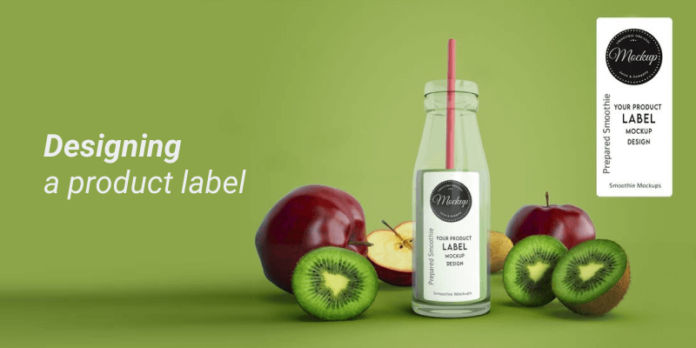At first glance, package design may seem intimidating, but it does not have to be; the most successful designs are built on very basic guidelines.
If you are searching for ideas on creating cosmetic packaging, food containers, bottle labels, electrical wires, or origami-inspired boxes, you are sure to find inspiration here.
Packaging turns 2D ideas into printed, tangible 3D creations; it is a highly efficient method to provide a product with a strong-branded appearance that persuades customers to purchase. Some of these key concepts are often supplied by the client, while others must be developed from scratch. Pleasing aesthetics may be difficult to achieve while managing this design job.
This article will assist you on how to make a product label with the least number of clicks.
What Are Your Labeling Options?
Before you begin learning how to create a label, you need to choose the kind you require. Do you need:
- Personalized Address Labels
- Labels with Calls to Action
- Labels for Products
- Stickers and Name Labels for Packaging
- Branded roll labels
The different types will determine how you move forward.
Address
Creating your customized address labels for the brand simplifies the process of sending out business-related communication. Include the logo on the label so that when it is applied to an envelope or package, it immediately becomes branded for a professional appearance. You can get personalized stickers for your products with all the details mentioned.
Call-to-Action
Call-to-action labels are little stickers that you may put on products to encourage customers to take action. These may be simple or complex but should almost always include an action phrase. For instance, call-to-action labels that read “Touch me!”, “Smell me!”, or “Look closer!” encourage your consumer to explore and feel your product’s advantages personally.
Products
Product labels are probably the most known kind of label. These labels are found on almost any product you may purchase and include information on the product, its advantages, its components, as well as branding.
Proper product labeling may assist in demystifying a product, properly communicating its advantages to the consumer, and making the product visually appealing.
Packaging
When it comes to delivering your goods, packaging labels for envelopes and boxes may enhance the consumer experience. Add labels with your brand to a box, or use one as an envelope sealing, and the whole product is immediately elevated.
Names
Whether your company is attending events or just wants name tags for front-facing employees, personalizing name labels is another excellent method to create a positive first impression.
The label material is also an object of concern because printing with low-quality materials can mess with the desired outcome. Inkjet Roll Labels provides high-quality label materials with a decent price range.
Guide for Label Designing
Group It
A successful label is the result of many components working in harmony. Each component is seen in context with the others. As a result, it is critical to group all label components together on the artboard before starting any size, positioning, style, or typographic work. After placing all of the label components on the artboard, you can begin the blocking process.
The term “blocking” is used in this article to refer to the act of shuffling, coarsely scaling, and provisionally arranging label components. It is a process of determining how the concepts can come together.
Make Space
One thing to bear in mind when blocking is that label placement is not a game of Tetris. A developer does not get a higher grade for fitting all design components into the given space evenly.
A pleasant label is often the nice balance of vacant and filled space. Consider how freed and unfettered the flavor names seem in the ample open space just above tiny information segments at the bottom. That is consolation.
Adjust Sizing
Because label designers seldom supervise print manufacturing or even see the finished result, they are likely to scale components according to each other without regard for physical proportion. In other words, most designers are content if a label design appears excellent on a computer screen.
Regrettably, this is a grave error. The actual size of a design feature is just as essential as its overall size in print media, particularly when it comes to typography! Just because something seems good on a screen does not guarantee that it will look good on paper. Indeed, after seeing a typeface printed on paper, the actual size of the type is often different.
What does this imply? Create a paper version! Any label designer should be printing trial labels from a printer regularly to ensure readability, spacing, and, ultimately, a physical sense of size.
Take a minute to remember the measurement that has been done and the significance for future projects! This scale setting effectively adjusts the design work shown on your computer to the precise size it will be printed. Bear in mind that the zoom level will vary depending on the design software.
Perceptual Hierarchy
When customers take a product from a shelf, they visually acquire design components in a specific sequence. This arrangement undoubtedly contributes to how pleasant a label seems and is mainly decided by the designers through different size, color, and contrast.
A smart designer would manage the perceptual hierarchy so that design components are presented in a logical sequence. Consider the following hierarchy: attention grabber > brand name > product name > product information. This is a simple hierarchy that directs the viewer without becoming perplexing. Finally, this label presents the observer with the most critical information, followed by the less critical information.
Conclusion
The ideas described above are intended to serve as general guidelines. There is no one-size-fits-all design formula. Instead, label design is a collaborative and push-pull process heavily influenced by the designer’s inspiration and product type. These principles are intended to steer a spontaneous and creative imagination to a unique and logical outcome. Check out this helpful resource if you are looking for commercial scales and packaging equipment and efficiently manage and organize your cable wrap around labels with our versatile cable wrap solutions, offering practicality and ease in bundling and securing cables without the need for additional labels.







